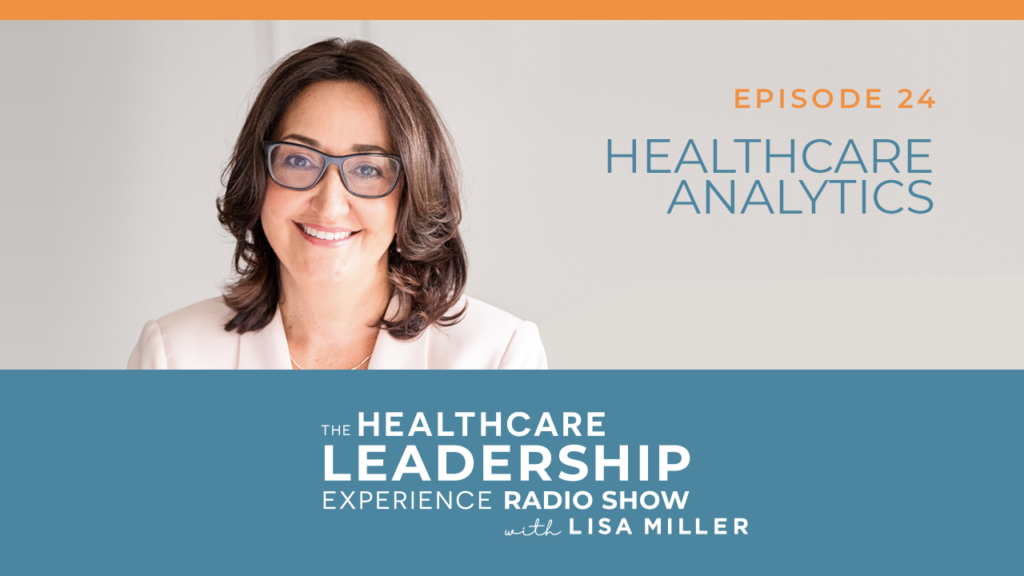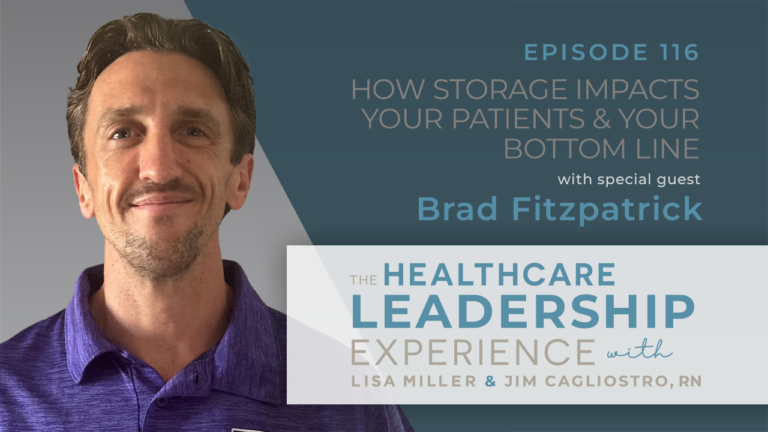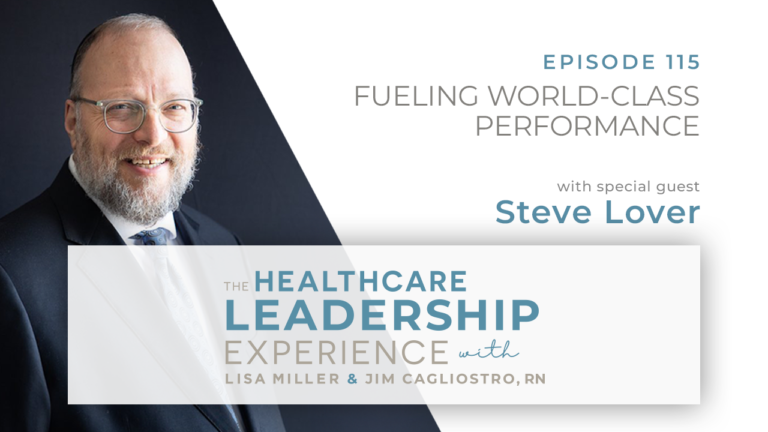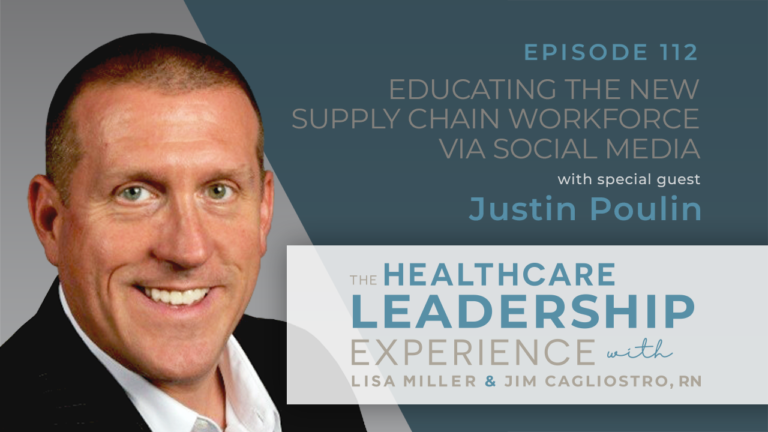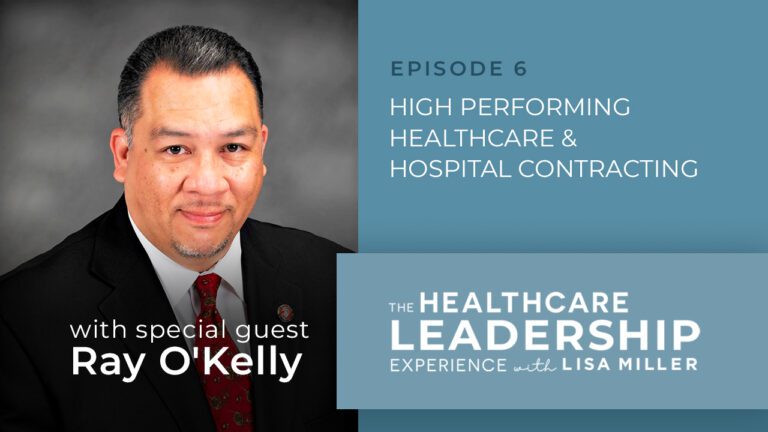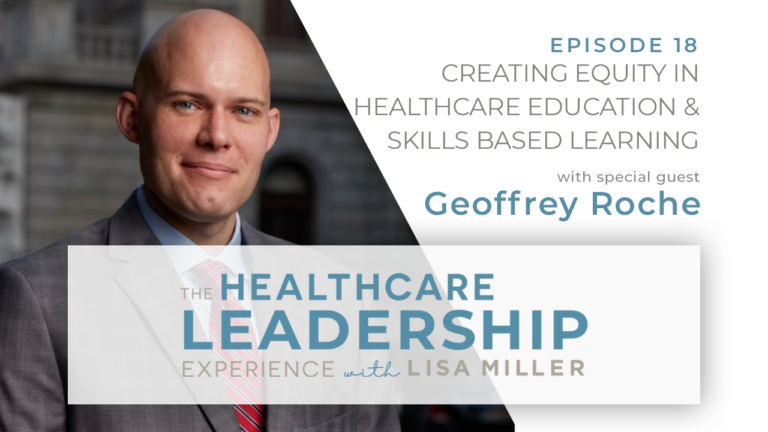In Episode 24 of The Healthcare Leadership Experience, Lisa is joined by her producer, Lisa Larter of The Lisa Larter Group, to discuss healthcare analytics.
As Lisa observes: ‘‘Purchased services is about 50% of a hospital’s non-labor spend. It is enormous. You cannot push a button and run a report and get line item details. So if you can imagine the challenges for analytics…. contract compliance… to build an RFP, to renegotiate, to see trends that are happening, it’s impossible.’’
This episode is sponsored by VIE Healthcare Consulting® which has proudly helped hospitals save $772 million since 1999.
In today’s episode you’ll hear:
Why a historical baseline of 12 months is the absolute minimum to go forward in cost analysis – and why thinking in averages is flawed. ‘’If the cost is going up the average doesn’t show you that. … we look at trends … averages in analytics can be dangerous.’’
The impact on your hospital margins of inflation. ‘‘If all of your spend had a 3 or 5% increase, what does that mean for your bottom line?’’
Why every hospital needs competency around spend analytics to build a cost savings pipeline.
How physician cost awareness can impact your hospital margins (and the study that revealed a 13% cost gap between cost aware physicians and those who weren’t). ‘’The power of analytics is that we become cost aware.’’
How your data tells a story and how you can ultimately use that data to impact the patient experience and your hospital’s cost savings goals (Hint: It’s not all about dashboards).
Four areas to get started in healthcare analytics. ‘’It’s better to be successful in one or two areas and build from that than be overwhelmed.’’
Why the biggest challenge in understanding the cost savings in your purchased services spend is getting to your line item details – and why you can’t get to accurate numbers without automation. ‘’The number one question that everybody should be asking is how can you help us with the line item details?’’
Discover the cost savings hiding in the line item details of your purchased services spend with VIE Healthcare’s patented technology Invoice ROI™.
Plan your pipeline of cost savings opportunities in 2022 in Episode 22 of The Healthcare Leadership Experience.
CLICK HERE TO DOWNLOAD THE PDF TRANSCRIPT
Connect with Lisa:
📧 lmiller@spendmend.com
📱https://www.linkedin.com/in/lisamiller/
CLICK HERE TO OPEN THE FULL TRANSCRIPT
Lisa Miller (00:00):
In purchase services spend, hospitals cannot get to the line item details with automation, that’s fact. So, the only way that they can get to the line item details for their purchase services spend is by going to their invoices and either reviewing it manually, typing it into Excel, or if they work with us, we have patented technology that extracts the invoice details and analyzes them to their contract and has all the spend analytics. Purchase services is about 50% of a hospital’s non-labor spend. It is enormous. You cannot push a button and run a report and get line-item details. So, if you can imagine the challenges for analytics, the challenges for contract compliance, the challenges to build an RFP, to renegotiate, to see trends that are happening, it’s impossible.
Speaker 2 (00:52):
Welcome to the Healthcare Leadership Experience, a place where healthcare leaders will share proven strategies and innovative approaches to leading the clinical and business side of healthcare. This show is sponsored by VIE Healthcare Consulting who’s proudly helped hospitals save over $700 million in non-labor costs since 1999. Here’s your host, Lisa Miller, founder, and CEO of VIE Healthcare.
Lisa Miller (01:15):
Hi, this is Lisa Miller with the Healthcare Leadership Experience. And today we’re going to be speaking about healthcare analytics and we’re joined by Lisa Larter. Welcome Lisa, how are you today?
Lisa Larter (01:29):
I’m good, Lisa, how are you?
Lisa Miller (01:31):
I’m good. I’m good. I’m excited to have a conversation about this topic because you and I have had numerous conversations about analytics in our business and kind of measuring and monitoring and how we do that with our own businesses and how important and how transformative it’s been really to take a more data-driven approach to operations, metrics around money. And, you know, I’ll be interested to hear your thoughts when you’ve kind of always been, I believe, financially and operationally stoop, but you’ve taken that to the next level to really look at your data, to make decisions and how you monitor it each month. I’m just curious to see how that’s been for your business as we kind of jumped into healthcare.
Lisa Larter (02:14):
Yeah, for sure. I think that analytics are so important in any business and numbers don’t lie, numbers don’t have bias, numbers don’t have relationships, they are what they are. And I find that if I don’t stay close to my numbers and really understand what they mean in my own business, it’s challenging to make smart strategic decisions around growth and even around cost. You know, in my own small business, I have to make decisions around when to hire more people, when to invest in more technology. And I always say that you shouldn’t throw money at problems, but if you don’t have access to analytics, then it’s easy to throw money at problems ’cause you don’t know what you don’t know.
Lisa Miller (03:05):
Yes. It’s a great point about making decisions based on gut and kind of what we just see without going through historical data, taking disparate data sets and bringing them together and taking a complex situation and looking at it with data. And you could certainly take that data and then walk that data and talk to different people about it to get different perspectives, which I think is very wise to get frontline insights with that data, to put context to the data. However, it is absolutely true data. Doesn’t lie, emotions get taken out of it, you’re going to see things clearly. You know, it’s a subject that I think hospitals are having more and more conversations around. You’re seeing more focus on healthcare analytics and you know, we’re just going to have a conversation about different ways that hospitals can benefit from analytics and, and it can be anything from patient care management.
You know, really looking at let’s say DRGs and looking at a specific surgical line and taking the components by revenue code down and looking at the implant costs, looking at the lab costs, pharmacy costs, looking at length of stay. And doing some real line-item analysis by physician, you could input social determinants factors into a DRG analysis and certainly, you know, those high-risk patients and you can slice and dice and add data to really focus in on something very unique, something that can really change patient care. But it does require time and thinking and being able to be comfortable in different data sets, but certainly patient care management is a big reason why a hospital would want to put together an analytics offering.
Lisa Larter (05:02):
Absolutely. You know, one of the things that you talk about all the time, Lisa, that has actually had an impact on my business, which you may not even realize is looking at line-item details. We often quote large marketing projects and one of the practices that I’ve put in place is what I call a post project profitability assessment. And we take a project because when you’re working on a project, you’re making assumptions around what it’s going to cost you and you’re making assumptions around the profitability associated with a project. And in some cases, things happen that cause you to go outside of scope.
And some of the assumptions that you make are flawed. And so by looking at our post project profitability assessment, it really helps us to get honest about how long it really takes to do the work and what our pricing model should really look like as we move forward. But if we didn’t take the time to do the analysis on the line item details that way, then it’s almost like we’re not carrying the lessons that are there to be learned forward in the business. I think the same is probably true in healthcare.
Lisa Miller (06:18):
It’s such a great point. You know, one of the aspects that I kind of talk a lot about is this historical baseline and whether it’s mapping or foundation and whatever you’re looking to analyze, it’s not to be analyzed in that month, per se. We do need to monthly measure or monitor, but if you’re going to get an understanding of where you are, you need a 12 month look back. And so for you, you, you did a look back on a project, right? It was real. It was, these are the hours spent, who was involved, this is the cost. This is a real look back and it’s so wise to do that. And, you know, when hospitals take a look back on service lines or specific DRGs, or take a look back on their contracts, whatever they need to do, it’s, it’s an important part of the go-forward process.
You know, that’s how you can fix and improve or find out where, you know, uh, there could be errors, but the look back, the foundation is absolutely critical. And it is by line item detail, we come into a lot of data analysis that was, you know, done prior to our work and we see a lot of aggregate, averages and well, the average cost of this case, the average profitability, the average reimbursement. And, you know, I think that that’s an okay start, an okay analysis, it’s when you start breaking down to the components, well, how are we paid by payer?
Lisa Larter (07:53):
Sorry, I’m just thinking, I’m sorry, I don’t mean to cut you off, but thinking an average is, is flawed because if the trend is that the cost is going up, the average doesn’t show you that. So, in our business, because we’re looking at every project we do, we’re looking at the trends, we’re looking at, you know, where are certain things taking longer across the board? We’re not just looking at the average because the average is the average of the lowest and the highest. It doesn’t allow you to see if the trend is actually moving out of control. I think average is potentially when it comes to analytics, can be very dangerous.
Lisa Miller (08:34):
Yeah, I think you’re absolutely right. So when we look at profitability, surgical line profitability, we’ll always typically see one or two cases that have just as an enormous reimbursement and those are becoming less and less, [inaudible 00:08:48] comp cases and then a bunch that are zero pay, which need to be looked at right. I mean, zero pay or very low pay, you need to be focused on, but it’s everything in the middle. It’s, you know, the different payers and why the variance and, and maybe there’s a mistake or maybe there’s a lag, there’s all different reasons why. But you’ve got to break things into components and you’re right. We see a lot of averages. We see dashboards for purchase services that are completely based on just monthly total spent average or ratio benchmarking taking up. Annual spend number and divided it by bed size and saying, your purchase servers spend for lithotripsy by bed size is this, and you’re comparing to other hospitals who may or may not have a full lithotripsy service.
Then they have different, you know, in-source, outsource, and you’re making bad assumptions. I think averages, you’re right, I think they are dangerous. And, and it’s about the line item details. It’s about really getting to granular levels of analytics. And I think there’s not a lot of that still going on in healthcare, I think it’s merging, and it has so many areas that it can be utilized in. We do patient satisfaction analytics, and we take in data from the internet right to the reviews. And we’re able to pull that into other aspects of patient satisfaction and get to, again, disparate data sources by line-item detail, looking at what people are saying. So you can use analytics even for something like patient satisfaction, not just the surveys that go out, but what else is the marketplace telling you? You know, what are the comments being made? What are the one to five scores they’re giving to your hospital on a review?
And as we pull in this data, we get a better story, but it is around the line item details. One of the areas that I think we’ll talk on the cost side, why it’s so powerful on, on analytics is spend analytics, right? So spend analytics is going to look at a couple of things. It’s going to look at like implant spend, supply spend, purchase services spend, but we’re also going to look at the pricing, what’s going on month to month? What’s something that pops up? Like I challenge people here, do you know your top 25 high costs supply items right now? Can you kind of say, oh yeah, I, I got that in the file list, I can pull it right up now, my top 25 highest cost supply items, not capital supply items. Do you know your top 25 highest cost service items?
Could you say, oh yeah, my largest service costs by item, not total spent is X? Could you do that by department? Could your department leader tell you what are the 25 highest cost items in their department service items? How do you measure that every month? What if a new item comes up, a service item? How do you know that that’s popped up, should be looking at it for trends? Like you said, Lisa, right? Specific trends. Utilization analytics is absolutely key, is a doctor doing something differently? Wait a minute, why is that doctor adding another biological or, or why that’s interesting? They’re adding two more screws they never added to that case before, I wonder why. Does he know, he or she know that we don’t get reimbursed for the extra two screws? Maybe there’s a real reason, but we have to kind of present to them that the two new screws have added $1,500 to the case cost, so we have to justify that.
But you can’t have those conversations unless you have the analytics. And so you need to have an historical view as a baseline and then from that baseline build measuring and monitoring. And I think resources are challenging for hospitals. And unfortunately, they’re getting even more challenging, but the area of analytics is so key that they need to have a, a partner then that helps them with analytics. Even if the hospital says, listen, we want to pick three projects in 2022 to perform analytics. We want spend analytics, we want some utilization analytics around our physicians and clinical costs. And we want to look at some of our high cost patients or the elderly, or we w- because we want to have better care intervention, we want to be proactive and we can treat patients at home. We want to reduce readmissions. The best way to reduce readmissions is in your data because your data is going to tell you why patients are being remitted.
And I will tell you probably the vast majority of the times you can get that data and then you can put interventions. You could say, oh, well, that makes sense, of 60% of our readmissions is because they’re not taking their medication. Yes, it’s outside of our control, so we need to put in a program and the best program we’re going to put in a health coach, a tele-health health coach who calls the patient and just reminds them about medicine or some kind of collaboration with the pharmacy, I think that’s key. So you have the analytics that is able to guide you and then you need to have these strategic meetings and ways to put a plan in place, right? So to have the data and to interpret it wisely and then to make those corrective actions to be innovative, there’s some fabulous work going on with managing those high cost patients, those patients that have a lot of issues and managing them at home. And the data is steering those conversations, so those conversations now can be more about how can the family help? How can-
Lisa Larter (14:27):
I think the 80, 20 rule is important here too. ‘Cause I’m assuming that, you know, 20% of the highest cost items are, you know, are, are probably correlated with 80% of where your total spend goes. And 20% of the highest cost patients are probably correlated the same way. And if you take that and you prioritize that 20% and you keep your eye on that 20% right now with everything that’s happening in the marketplace around supply chain and inflation, there’s probably some markers that people really want to pay attention to in that spot.
Lisa Miller (15:08):
Yeah. So I think that’s a great discussion to have because as we move into a deeper inflation that we’re going to see, it’s not speculation, it’s here. It’s going to get worse. How much worse it’s going to get? We don’t know. So if we just talk on the spend side, the spend side, what are you doing to really measure, monitor and understand increases? So they may come in a few different forms. They may come in a slow, subtle increase, right? 2%, 3%. But think about it, if all of your spend you had a three or 5% increase, what does that mean for your bottom line? What does that mean for your margin if overall it’s going to go up 5%, maybe more? We don’t know, where do you make that up? We can’t make that up on the revenue side. Where do you make it up?
And so I, I’ve been talking to hospitals a lot these last few months on them having to be very proactive. And you and I talked about it recently even anticipatory and to be resetting everything, resetting their contracts, resetting, looking at utilization, having conversations with physicians but it all comes back to analytics. And how do we put this together? How are we creating the story and spending the time and making sure that we’re getting to the specific line item details? You know, how, how are you supporting your departments? Your departments are running really hard now with, you know, with the pandemic. And, you know, as we should be, this is all about getting through this together.
How are we helping these department leaders get to understanding their analytics or giving them tools so they have analytics? And it’s not dashboard. So I love hopping on to dashboards and you know, I even have QuickBooks so I can look at dashboards and see things moving. And, but the reality is, is that most of these dashboards don’t drive to the line on a details. They don’t get to the specificity, they can’t do the thinking. Like you can have the dashboards as a part of your work, but you’re going to have to roll up your sleeves. And you’re going to have to kind of get into the data, do some what if scenarios, look at 12 month trends, last three month trends, what’s new, you know, kind of look back and, you know, into the agreements and just do some analysis, we’re talking on the spend side.
But frankly, I think every hospital needs to have a spend analytics initiative. We talk about supply chain. We talk about strategic sourcing. We need a really great competency around spend analytics and what is spend analytics, spend analytics is really a focused initiative around all of your non-labor spend and slicing and dicing and measuring every month and looking for variation, opportunities, not on a one-time basis. We have talked about it in the previous episode about building a cost savings pipeline, but this is about real month to month measure and monitoring of your spend.
Lisa Larter (18:18):
It’s super important. You know, I read a stat the other day, Lisa, that someone published and they said that 5% of employees understand the strategy for the organizations that they work for. And so if you think about how important analytics are and cost savings are to health care, it just makes me wonder, you know, if only 5% of people understand strategy, the organization strategy, what percentage really understand the analytics that are associated to the day-to-day work they do, and really understand the impact that they make and how it rolls up to the organization’s big picture strategy?
Lisa Miller (19:05):
Yeah, yeah, absolutely. We work with physicians quite a bit and yes, every hospital health system has a strategy. And part of the strategy is, now is, is performance improvement, margin improvement. Right? And you know, they’re just big words, you know, it’s like, okay, well, yeah, we, you know, we want excellence, we want performance improvement. And, but does that average person or that frontline employee really know what that means and what they can do? And I think that’s a big untapped opportunity to be able to, you know, have a presentation to the organization, whether it starts at leadership and then the departments and then to the frontline team about costs, right?
Be cost of aware, we have a program called Cost Aware for Patient Care. And I will tell you that most people don’t understand the relationship between reimbursement to costs and, and how important they are to one another and to the things that they can do. There was a study done by JAMA. And it was interesting because it measured physician cost awareness. It wasn’t changing physicians practices, it wasn’t asking a physician to get involved in negotiation. It was just cost awareness. It was after the surgical case, the physician was given their information on costs. So that’s implant costs, fly costs, just their information, just showed them the information. So that was the one group, the control group didn’t get to see their information.
So physicians who saw their cost information post-surgery had a decline of over 7%, right? They reduced their costs by 7%, just the information, that line item information, the analytics, the analytics of their spend in their case. The group of physicians who didn’t see their costs increased their costs by 6%. So there’s a 13% gap, an opportunity, right? Just in being cost aware, cost line item analytics for the case, that was it. I mean, then you can layer on standardization, you can layer on utilization pricing, but just to be cost aware. And I think that’s the power of analytics is that we become aware, right? Oh, I didn’t, I didn’t realize that, that’s an interesting thing I’m spotting here. You know, we’re showing a high relevance of elderly patients above, you know, 90 that aren’t getting a followup appointment to their GP, whatever the nuance is, you’re going to see things in your data that you can’t even imagine it.
I think it’s going to surprise you, it often surprises me when we go through data. I’m like, wow, that’s, that’s fascinating. And I, and I think your data tells a story. What are the stories in your data and how can you ultimately use that data to impact patient care, to impact your goals? Like you said earlier, and giving data to the frontline workers, employees, to give data to those department leaders. But I think there’s just a lot of power in being able to not just have a dashboard, you know, it’s not about Tableau or power BI or any other dashboard and, you know, pulling in data sets, it’s really is the thinking, it’s the thinking around the data and what you’re doing with the data.
Lisa Larter (22:37):
So, Lisa, what do you advise the hospitals that you work with? Because you, you know, VIE does some pretty big projects with hospitals to help them really get to the line item details so that they can have a better understanding of their data. Where do you recommend hospitals start and prioritize their focus when it comes to this? Because when I hear you talk about healthcare data and I hear you talk about patient care and I hear you talk about readmissions and utilization and like all this stuff, it feels overwhelming. So I understand that when something is overwhelming, you have to break it down into manageable pieces. How do you help hospitals do that?
Lisa Miller (23:28):
It’s a great question. So there’s a number of ways. Either a hospital has a specific area of concern where they really want to get to data. So wanna get to the data so they can uncover opportunities. So they have a specific need, so that could be in spend, that could be a managed care, that could be in social determinants of health. It could be in a number of places, it could be in the OR. But the hospital’s going to say, we, so w- where should we begin with the analytics? There’s a couple of areas that we’re consistently looking at that there’s opportunities and they can build, right? It’s better to be successful in one or two areas and build from that than be overwhelmed with, you know, there’s just so many different ways to look at this. So I think number one is a true deep spend analytics capability.
It’s not your GPO doing it, it doesn’t come from different dashboards. It’s actually taking all of your data and figuring out the things that are important for you to see, top spend items, top supply items, service items, month over month, you know, what are the three or four metrics that are key to analyzing? Anything pops up new, is anything, uh, month to month over increased? So you have to start with spend, the reason why spend is a great area is because it’s the largest part of your expense outside of labor. And you can really kind of control that, you can capture things as they’re happening. So number one, it has to be spend analytics. If you don’t have a spend analytics platform, please call me, not even a platform ’cause we’re platform agnostic. You just need to have the building of that internally, you can do that in Excel [inaudible 00:25:09].
You can do that in a number of different places, it doesn’t even necessarily have to cost so much, it just have to be an official platform. It could be pulling that data together and having it formulated, you know, in those areas that you want to keep an eye on. I think the second area is managed care analytics and that’s really important because a lot of these contracts now are value-based agreements and those agreements and those managed care and analytics needs to be looked at from historical spend, but also on a monthly analysis. Your managed care providers are performing deep analytics on you and they know a lot about your hospital and your patient population and the cost. Likewise, having a managed care analytics program in place, so you can understand and measure their performance and make sure that the contract is performing in ways that you can get those additional incentives.
And I would say in other areas that are really important is population management analytics and also on patient satisfaction, those are really great, four great areas that could probably give you a 30, anywhere that you have an area where you want to improve, you can definitely infuse analytics. It doesn’t need to be complicated. You don’t have to buy a platform. Most of this can be done in Excel, it’s surprisingly simple. There’s probably platform fatigue out there. You know, there’s so many platforms, there’s so many dashboards, there’s probably a lot of simplicity that needs to go into analytics and more thinking, right? So we help hospitals put those together and help them identify those opportunities and then put together those solutions to solve those challenges or solve those opportunities quickly.
Lisa Larter (27:01):
So, one of the things that I’ve heard you say before, Lisa, is that hospitals struggle with getting to the line item details. They, they don’t know how, like it’s a really manual, labor intensive process to do that. But hospitals that work with you are able to overcome that challenge. Can you talk a little bit about that? Because if we’re talking about healthcare analytics and we’re talking about how important those details are, then to me, it almost seems like the very first obstacle that you need to remove is access.
Lisa Miller (27:37):
Right. Great question. So specifically in purchase services spend, hospitals can not get to the line item details with automation, that’s fact. So the only way that they can get to the line item details for their purchase services spend is going to their invoices and either reviewing it manually, typing it into Excel, or if they work with us, we have patented technology that extracts the invoice details and analyzes them to their contract and has all the spend analytics. Purchase services is about 50% of a hospital’s non-labor spend. It is enormous, right? The other half of the non labor spend, it’s supplies, it’s implants. So this whole big other category, purchase services, 50% of the non-labor spend, you cannot push a button and run a report and get line item details. So if you can imagine the challenges for analytics, the challenges for contract compliance, the challenges to build an RFP, to renegotiate, to see trends that are happening, it’s impossible, it’s manual. It’s an eyeball look, it’s a guesstimate.
And this is an area where hospitals are being sold platforms and being sold different ways to look at averages and ratio benchmarking, and spending money in areas that don’t drive to the problem. The problem is line item details, the details matter. And so we help hospitals in this very complex area, purchase services, get to the line item details. We are coming up with opportunities that it’s been missed by so many people and not because, you know, anyone’s not doing a good job. It’s impossible to look at hundreds of pages of invoices and to perform an analytics, right? Easy to take an AP spend report and pull that data and show monthly spend, that’s easy, difficult getting to the line item details and performing line item purchase services spend analytics. And so anyone can kind of sell a service, a platform in this area.
But the number one question that everybody should be asking is how can you help us with the line item details? And please don’t tell us that, you know, you’re manually putting them into spreadsheets. ‘Cause if you’re manually doing it, then that’s prone to error. That’s not very time efficient, it’s going to take you forever to do our purchase service initiatives, or if you’re just doing a month or spot checking it or you’re basing in our contract, it’s going to be flawed and you’re not going to get us the opportunities. And unfortunately, a lot of hospitals are buying into this and, you know, they’re not getting the absolute best results they can do because the details matter. And so, you know, we can spot the extra spend. We can spot the things in purchase services that get missed because we, we’re be in so exhaustive and comprehensive to the line item detail.
And I often tell my hospitals, you wouldn’t analyze your implant spend the way you analyze your purchase services spend. And it’s because you can’t get to the line item details. So that’s definitely a challenge and it, it also requires time. In general, I think the thing that we’re seeing more and more is that hospitals are resource constraint and, you know, you feel it with the pandemic, you feel it with all these things going on. And, and it’s now gone on for so long, you know, just to layer all these other operational issues on top of them., you know, it’s tough. And I think that’s why our work is more meaningful now than ever because they have so much on their plate. And if we’re able to take things off their plate and help them drive to their initiatives and exceed them, that’s a win-win.
Lisa Larter (31:23):
Absolutely. Can you talk about, like when you are looking at the line item details, all of those line item details, obviously roll up to big data analytics inside of a hospital. What are some of the things that you find that hospitals least expect or don’t realize are happening when you are able to dive into those details?
Lisa Miller (31:47):
Yeah, it’s great. It’s the nuances, it’s the added costs. It’s the errors. Like for instance, we were looking at a outsourced radiology contract, one of our clients, we review those outsourced physician service agreements. So that’s, you know, it’s not just benchmarking, certainly we can benchmark, but it’s really looking at the whole contract and looking at the details, those invoice details and getting that historical spend by detail. And so we were benchmarking their radiology, Alter’s radiology services, and there was so much different complexity into this agreement, but the agreement allowed for a fringe rate to be added to the employees on the agreement, but non physicians, right? To anybody who was non-physician, could be other clinicians, but non-physicians, they get an extra percentage for fringe rate.
And as we were going through the details of the invoices, and we noticed that the physicians were charging the fringe rate on their costs, on their pricing and it was about over $300,000 in an overcharge, actually it was like $360,000 in overcharge, the details mattered, right? That’s one example. We have another example where, you know, we’re seeing this more frequently on the purchase services side, where the hospitals are being billed by let’s say, outpatient visits or bedside or birth. And so we were looking at a new contractor a hospital had versus the invoice details versus prior contracts and pulling in all the data. And in fact, they were given the wrong birth rate number. They actually had a lot lower birth rates and it basically reduced the costs by 30% when we right-sized the birth rate numbers, you know, in the contract. We find surcharges, we find errors, we have found a two cent line on error that was a, just a flat-out mistake. It was an old legacy agreement that rolled into a new agreement that had been hundreds of thousands of dollars.
We find wrong CPI increases. We find wrong prices. You know, we find little additives that were never included like new service fees or COVID fee charges, just all these little things that we talk about adding three or four or 5% per year, we’re seeing on some of these purchase service agreements that they’re adding seven to 10% of unnecessary costs.
Lisa Larter (34:28):
And that’s before inflation hit.
Lisa Miller (34:31):
And that’s before inflation hit. Yes. Yeah. And it’s really interesting as these line item details come in, you know, there’s double charges, there’s, there’s mistakes in pricing, there are new brand new tests, right? So we monitor a lot of our hospital’s outpatient lab tests. So we’re able to say, wait, that’s a new test that’s ordered. And things that pop up at this price or physicians that change utilization, we’re able to see it in their spend. So we had one example where we were monitoring physicians implant costs. We were performing the spend analytics and, and sending out those analytics for implants for one of our hospitals. And we noticed this increasing trend of one of the doctors using a revision component in a primary case.
Let me give you a background, when you have a knee replacement or hip replacement, we’ll say, talk about knee replacement now, it’s called the primary case. It’s the first time you have a knee replacement, but let’s say you need a secondary replacement, it’s called a revision. So revision cases are more expensive, they’re, it take longer because they’re taking out the primary components and they’ve got to put, you know, new components and just a lot more complexity, a lot more time and it takes different kinds of components than a primary. But this doctor was using a revision component and there were, there’s reasons why a doctor would use a revision component in a primary case.
It could be a, a weight issue. It could be an oncology issue. And we had just seen the increase going up. And we finally, we had a meeting with the physicians and we mentioned it and he said, well, I’m, I’m not using it all lot. We were like, okay, well, it’s 34% of your cases, you’re using a revision component. He said, what? He said, I thought I was using it like less than 10%, I had no idea I was using it that much. And he’s like, I, I need that information. I need to look at that, that should not be 34% of the time. And that’s the things that we see when we were looking at the line item details and we’re able to present it.
And of course, in a very respectful, conversational, informative way. And the addition to that 34% is that reps in the room. And I’m not saying that the reps making the decision, however, it surprised the physician that he was using so many revision components in primary cases, he thought it was less than 10% and the numbers were something different and he of course corrected. Uh, you don’t get more money from reimbursement when you use your revision component. It just eats away probably the, the entire margin. So, you know, those are some examples. And the other example, I think, and you know, this is a tougher conversation to have, but you know, I have employees, I have team members and so do you, and we have to trust they’re doing the absolute best job every day, which I know my team is doing, I know your team is doing.
And they’re working hard, they’re thinking, they’re striving for excellence and they’re doing the things that they’re supposed to be doing. However, you and I would not be doing our jobs if we didn’t check in, we didn’t have some way to question things if we see them, if we didn’t have a second opinion or an assessment or some way to look at, to measure our performance versus others, or could we be doing this better? Let’s just say, it’s not even about performance, we just want to do a better, w- we want to level up. And I see a lot of things that go on that, you know, in terms of benchmarking or analytics and a lot of decisions that are made, that could be way better decisions. And it’s unfortunate that that doesn’t, has better visibility. They think, oh, well, we’ve got platforms, we’re doing RFPs, we, we got supply chain, it’s all good.
And for the large part, it probably is. I just think that the line item details need to roll up to the C-suite. And so the C-suite can ask questions because I think different questions would get asked if the C-suite saw more line item details. And I know that they don’t want to get buried in details, they, you know, they want to have, what does this mean? Unfortunately, I think they’re going to have to see those details to ask questions about them so things get done. Some of the best CFOs that we work with are CPAs. And the great thing about that is they’re attuned to line item details. They want it.
Lisa Larter (38:56):
Well, and I think it goes both ways. I think, you know, I had a situation with a team member of mine who had a, I guess, a false belief on how profitable the work she was doing was to the company. And so she was making an assumption based on what we build her time for versus what it actually costs to employ her versus what it costs to run the business. And when I sat down and I explained all the details to that individual, it was really eye-opening for them because they hadn’t thought about it that way. And so I think that those details are important managing, like for the C-suite, but I think they’re equally as important for the frontline people because I think when they know better, they do better. But in the absence of giving them the information, they make decisions based on what they know, and they don’t know any better if you’re not sharing those details and analytics with them.
Lisa Miller (39:59):
It’s a great point. So one aspect of our Cost Aware for Patient Care Program is explaining reimbursement and costs and explaining that, you know, Medicare could be 60% of their payer mix and they are capped, this is what Medicare pays. And so if you’re adding cost to it, you’re eating away at your margin and it does matter. Like I’ve [inaudible 00:40:22] well, it really doesn’t matter, you know, the charge capped, things don’t really matter ’cause we get, you know, we get paid and we’re fine. And, and I think you’re right, I don’t think they understand the profitability, the decisions that one or two things can make, could have a big impact on profitability. And, and I actually think also that physician cost awareness is key. Absolutely key ’cause as I mentioned early on the JAMA study.
So you’re right, it goes both ways. It’s giving information up and down and, you know, being able to have those discussions and, you know, be fluid. But overall, yeah, this is a great discussion on healthcare analytics, because any context whether it’s the revenue side, it’s the patient care side, it could be analytics, you know, on the marketing side, of course, the spend side is so important, but population management, you name it. If you’ve got data, I would encourage you to start dipping your toe into analytics, any kind of data, start by taking it a few small steps, like showing like you did, showing your employee that things weren’t, you know, the way she thought they were being.
And, and I actually have one last story and I’ll end, we did a very, very complex negotiation with a very, uh, wonderful, famous, highly skilled spine surgeon, very sensitive kind of discussion around cost and implant. So we put the data together, um, where we thought the pricing or we knew the pricing should be. And we explained it sat down, sat down, sat down with the CFO, CEO was very, very high stakes negotiations internally and, you know, benchmarking because of his position. And so internally, everyone felt comfortable, we presented the physician and he sat back and he was not believing us at all. And his comment was, I make so much money for this hospital and I don’t agree. I bring in so much volume, I make so much money and he didn’t agree because we needed his help in the negotiations because the vendor was not working with us. So basically, he said no.
So he made the hospital so much money. So I said, okay, let’s do this. We felt like we s- we gave you a lot of data on pricing and how we came up with this and the market and try to make you feel confident, I’m going to go back and get all the reimbursement data and we’re going to show you profitability. And so the next meeting we came up and we had ran, did all the numbers on profitability. So we, you know, we understood his case mix. So what was interesting is that over 65% of his cases were Medicare and Medicare only pays one price for spine cases, whether it’s a one level or three level, four level, it could, you know, and I think that something like 70% of his cases were two, three and above levels. So that margin significantly reduces, in some cases they were upside down.
So to make a long story short, we showed him his profitability and the profitability was very little, based on the pricing of the implants, we could get him to the profitability of the hospital where we needed to be. And we showed it based on different payers and different surgeries that he did. And literally within like five minutes, he called the rep, the rep called us and they agreed with the pricing we had asked all because of the data.
Lisa Larter (43:46):
That’s the power of analytics, they don’t lie.
Lisa Miller (43:49):
Right, they don’t lie. So what a great conversation, Lisa, thank you so much. You know, I appreciate the, uh, personal stories. You know, we probably can go on and on about analytics in different ways, shapes and form. Hopefully, we’ll have another part to on this conversation. So I thank everyone for listening to today’s episode. We have our previous episode 23 on high-performance project management, which really goes hand in hand with analytics as you’re planning out, you know, those opportunities that you uncover. And then next week’s episode 25 will be on prioritizing purchase services. So if you have suggestions on future shows or comments, you’d like to get ahold of me, we’d love to hear back from you. Lisa, it is always awesome to have discussions with you. Thank you for being on the Healthcare Leadership Experience.
Lisa Larter (44:41):
Thanks for having me. This was fun. I love talking numbers with you.
Lisa Miller (44:45):
Thank you, Lisa.
Leah (44:47):
Hi, this is Leah. You are listening to my mom’s podcast, the Healthcare Leadership Experience.
Fernando (44:54):
Hi, this is Fernando. If you would like to speak with my mom, just email her.
